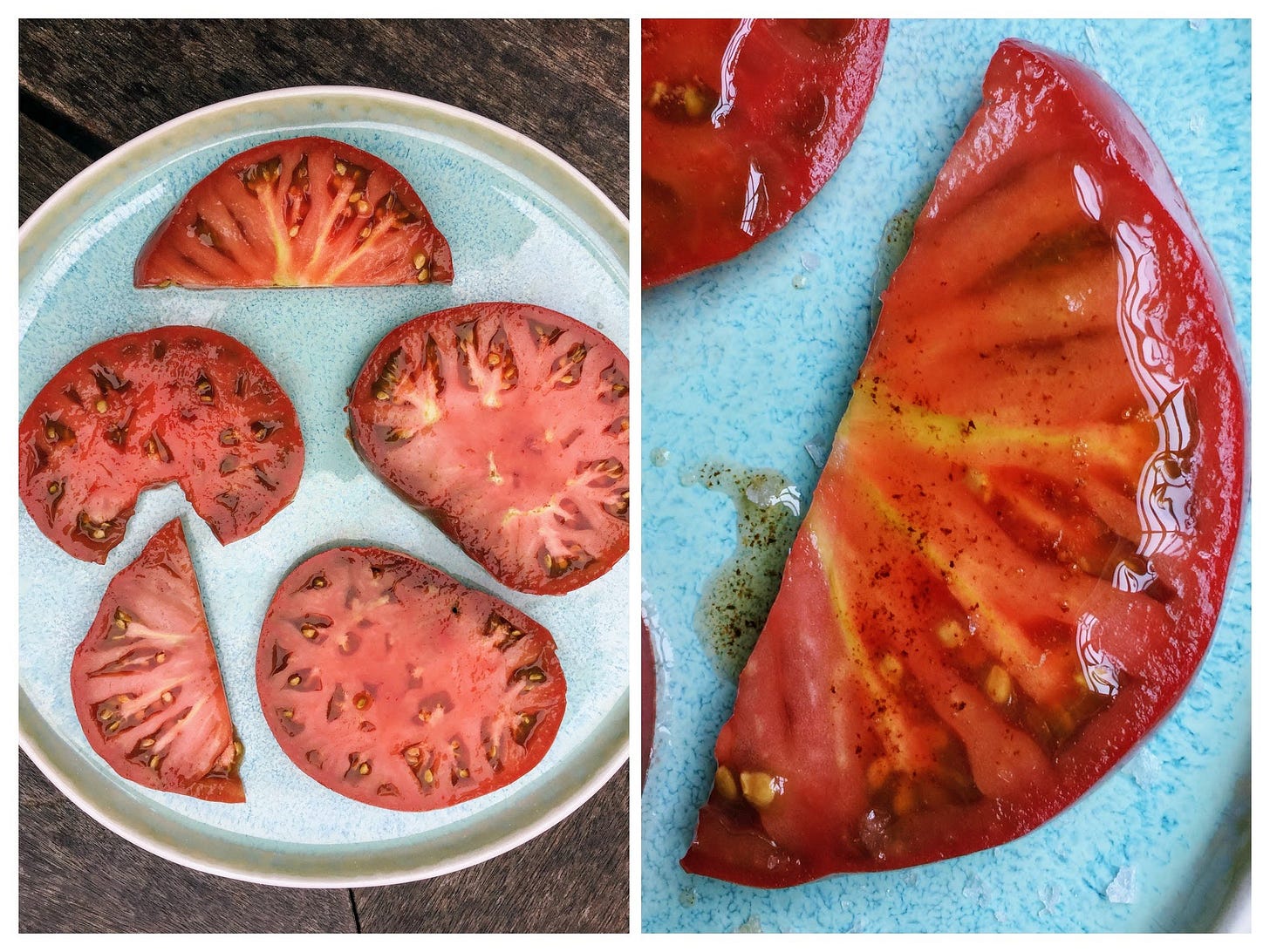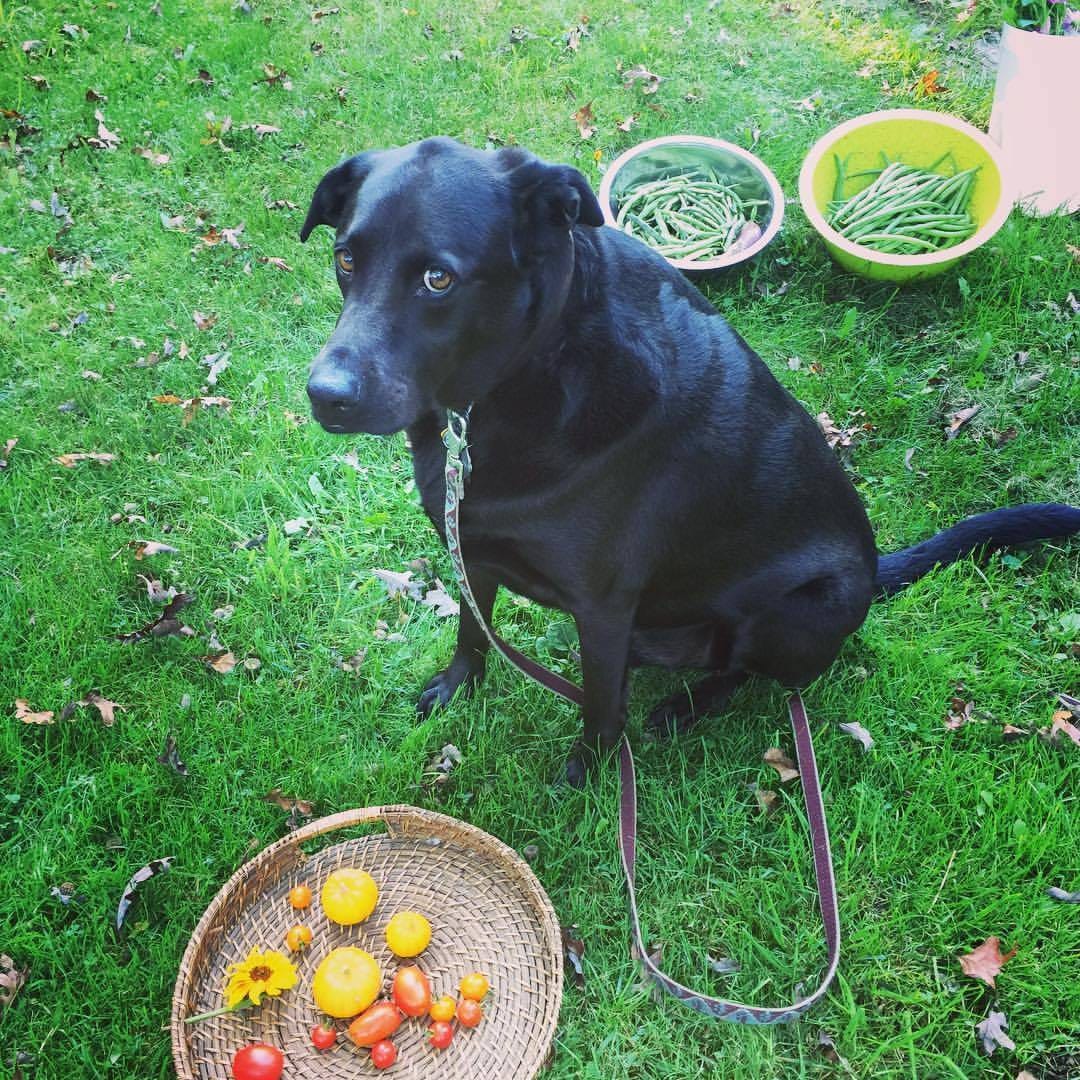My New Friend, the EpiPen: When a Food Writer Has Food Allergies.
Really bad ones. Not good.
I.
I stepped into my kitchen Monday afternoon to do a second test on a recipe I was developing with celery root for my Cook the Vineyard newsletter. I peeled and sliced, peeled and sliced. Heated up the oil in my stir-fry pan, added the celery root matchsticks, scallions, and lots of chopped roasted peanuts, let them do their thing and then finished off with ginger, garlic, soy, mirin, and cilantro.
I quickly transferred the finished dish onto my prop plate and plopped it in my makeshift “studio” – a breakfast room bench by a bank of windows – and took my photos.
I rushed to clean up as I was planning to join my husband for a walk while the sun was still high. I took a few bites of the dish to taste it – so, so good.
Off we went, trudging along the still crunchy-snowy path to Flat Point Farm, then circled back in the late afternoon light. As we came up the last leg – a dirt road leading to the horse stable near our house – I noticed my hands were itchy. I took off my gloves and started scratching both palms vigorously.
My nose started to run. Nothing unusual there; it was crazy cold out.
Parting the thorny branches on the path up to the house, I began to feel pressure in my ears – like I’d been on a descending airplane for far too long with no way to pop my ears. The back of my mouth suddenly felt like someone had stuffed a wad of cotton balls in it.
When I got to the back deck of our house, I mentioned all this to my husband, who was heading off down the driveway to tack a few more minutes on to his walk.
“It’s very strange, I feel like I’ve suddenly been hit by a bad cold,” I said.
I went into the bathroom to look in the mirror and couldn’t believe it – both eyes were bloodshot, and my right eye was significantly swollen.
Inside the house, I felt my eyes watering and I realized my right eye was very itchy. I went into the bathroom to look in the mirror and couldn’t believe it – both eyes were bloodshot, and my right eye was significantly swollen.
Just then, my husband came through the door, saying he was concerned about how I was feeling.
“And now I’m having trouble swallowing,” I said to him.
He ran upstairs to look for Benadryl and came back with various allergy medicines but no Benadryl.
“Well,” I said. “I’ve heard that Benadryl won’t actually stop a severe allergic reaction, anyway. I think we’d better go to the hospital.”
He grabbed his keys and a book (smart man), and off we went to the ER. On the way, my eye worsened and my throat remained stiff and swollen. It didn’t seem to get significantly worse, though the pressure in my ears intensified. I never felt like I was gasping for air though.
My husband dropped me off at the ER entrance, I walked up to the receptionist, and she asked me what I was there for. Then she looked up from her computer and said, “Oh, honey, your eye!”
I checked in, my husband and I sat down in the waiting room, and within a minute a nurse was there escorting me to an exam room. At least I thought it was an exam room, but of course this was the ER, so it was a room filled with crash carts and all kinds of machines, I later saw.
Silly me, I thought we were going to chat leisurely about my symptoms, but in a matter of seconds, my shirt was off.
Silly me, I thought we were going to chat leisurely about my symptoms, but in a matter of seconds, my shirt was off, an IV was in, and those sticky things with wires attached to them were all over my chest. (A cardiac monitor I guess?). Two more nurses had materialized in the room without me even noticing them come in. Then the doctor appeared to confirm the course of treatment the nurses had started on.
They explained they were going to prick me with an EpiPen. “We can do it right through your pants.”
I had enough sense to say, “Oh no, take the pants down – they’re my dirty walking pants!” (I was imagining bacteria penetrating my skin.) Into my thigh went the pen – the prick was not too bad – and into the IV in my arm went a dose of steroids and Benadryl.
The doctor told me that the adrenalin in the EpiPen would make me feel agitated, and that unfortunately, the Benadryl would make me woozy. The two would be fighting each other.
Pretty soon I did start to feel my arms twitch and my head get heavy at the same time. It was unnerving to feel all those meds in me, but I also quickly began to feel air filling my nasal passages and my throat relaxing its steely grip. With that, I realized how truly uncomfortable I had been.
My husband came in the room and I said to him, “I guess they take this stuff pretty seriously; they certainly jumped into action!” I thanked him for bringing me, and he — ever the lawyer — said, “Well there was no question that it was the right thing to do.” It seems that in his own mind, he had quickly weighed the pros and cons of a trip to the ER, and had resolutely came down in favor of the expedition. (Okay, not a hard decision, but one we have never had to make before.)
Being a little slow on the uptake, I also did not immediately understand that I would have to stay in the ER for observation for a few hours. I had naively thought I’d get treated in some way and sent home. (Unfortunately, a few hours turned to several hours because we were there during a shift change and the discharge papers languished. My husband’s dinner was a Rice Krispie Treat and a bag of chips out of the vending machine.)
I also didn’t realize I’d be sent home with an EpiPen, a prescription for five days of the steroid prednisone, and a direction to take Benadryl for 24 more hours. Apparently there are a certain percentage of people with anaphylaxis who experience “rebound” (technically called a biphasic, or two-part, reaction) – even if they have been treated with epinephrine.
II.
What did I know? Not much.
It turns out I don’t know that much about anaphylaxis1. Starting with the fact that I didn’t realize I had experienced it. I thought I was just having a severe allergic reaction to probably the celery root (I’ll explain why in a minute) but possibly also the peanuts.
I assumed because I was still functioning, and because the symptoms had come on an hour after contact with the food, that I was not in danger.
I always thought that anaphylaxis progressed very quickly, within a matter of minutes, and basically closed your airways down completely. I assumed because I was still functioning, and because the symptoms had come on an hour after contact with the food, that I was not in danger.
I did not realize that untreated, even moderate symptoms can continue to progress. (Anaphylactic symptoms are described as occurring in stages2, with anaphylactic shock – a narrowing of the airways and a severe drop in blood pressure – being the last stage nobody wants to get to.) And severe reactions to food apparently can sometimes take a little longer (even an hour or two) to show up – and a little longer to progress (up to 30 minutes) than those from a bee sting or a medication, which can happen in as little as five minutes.3 That slower progression might lull you into thinking you’ll be okay. But a delay in treatment is the number one reason people die from allergic reactions4, so it isn’t something you’d want to mess with.
How would you know if what you are experiencing is anaphylaxis as opposed to just a severe allergic reaction? Judging from what I heard from the nurses and the doctor in the ER, and from, of course, the internet scouring I’m now doing (insert big disclaimer here – obviously I am not a medical expert!), if you are experiencing symptoms involving two or more body systems (skin, respiratory system, digestive system, heart), this is anaphylaxis.5 In my case it was skin and respiratory. In less severe allergic reactions, the symptoms would generally be contained to one system.
And here’s the deal: the only thing that reverses anaphylaxis* is epinephrine (adrenalin). Hence the incredible medical device, the EpiPen. I’m sure some of you already carry these around with you for your own severe allergies or your children’s, but I am newly grateful for this portable life saver.
(*In some cases, anaphylactic symptoms will decrease on their own, but I’m not sure how you would divine this if you are in the middle of a reaction. Certainly for me, despite my initial nonchalant observation of worsening symptoms, once my throat tightened and I began to have trouble swallowing, common sense and appropriate caution kicked in fast.)
How did I get in this mess?
I’ve had bad hay fever all my life. I’m particularly allergic to ragweed, but to other pollens, as well. I had the prick tests and the allergy shots as a child and young adult. And then stood by waiting for my allergies “to disappear as you get older” as I was always told. Never happened.
Somewhere in adulthood I realized that my mouth started to itch every time I ate melon, of any kind.
Somewhere in adulthood I realized that my mouth started to itch every time I ate melon, of any kind. I remember a wheezing incident after the last time I ever ate watermelon. I twice found myself short of breath after being injected with dye for a breast MRI more than 20 years ago. Turns out there is something in the dye related to chamomile. Chamomile tea has always given me a stomach ache.
I also noticed more and more, in adulthood, that avocados, cucumbers, raw pears, raw carrots, and raw tomatoes got the back of my mouth and my ear canals itching.
And one day I was at a breakfast at a fancy hotel in Edgartown – a special PR breakfast arranged just for me to taste the chef’s food – and I was served banana pancakes and a smoothie with cucumber, banana, and kiwi in it. I had to drive straight home, not back to the office as I had planned, as I suddenly felt very sick. I had a stomach ache like I had never had in my entire life. It wasn’t food poisoning – it was different. I literally felt like I was going to die. In that case, though, when I got home and laid down (and called my husband who wasn’t my husband yet) the distress gradually decreased. I learned later that bananas, cucumbers, and kiwi all have something in common - a kinship with ragweed.
Hello, Oral Allergy Syndrome
There were other signs along the way – a swollen lip or a sneeze attack after eating a garden salad – but I still didn’t quite know what was going on until a couple years ago. I finally discovered that something called Oral Allergy Syndrome (OAS), also called Pollen Food Allergy Syndrome (PFAS), existed. It’s not that uncommon in adult allergy sufferers, though many people may not even realize they have it.
There are certain foods – fruits, vegetables, and nuts – that have proteins that mimic those in various forms of plant pollens. (See the chart below.) So if you have pollen allergies, you could be sensitive to these foods. When your body thinks it is being attacked by pollen, your immune system overreacts and produces Immunoglobulin E (IgE) antibodies that in turn cause cells to release histamine and other chemicals, causing the reaction.6

Generally, eating these foods raw will make your mouth or ears itch or give you stomach distress; often the cooked food won’t cause any symptoms at all. And here’s the interesting thing: You are not likely to have severe allergic or anaphylactic reactions with OAS. Having pollen-food sensitivity is not the same thing as having a specific food allergy, which is usually triggered by a different type of antibody. It’s a little confusing, but for instance, I may have a pollen-food sensitivity to peanuts, but I don’t (as far as I know – yet) have a deadly allergy to peanuts.
So why did I have an anaphylactic reaction to a pollen-food irritation? Because although it rarely happens (by one study, no more than two percent of the time), it can if the right factors are present.
First – the actual allergen. I have learned in the last couple of days that celery, in all its forms, is one of the most potent vegetable allergens. In the EU, foods containing any form of celery – juice, powder, whatever – must be labeled as containing allergens. Apparently, a high percentage of Swiss and Germans with existing food-pollen sensitivities are allergic (or highly sensitive) to celery - especially celery root. The percentage is much lower in the U.S. Maybe some of my German DNA is a culprit?
Celery, specifically celeriac (celery root) is a particularly problematic food.
According to The University of Nebraska-Lincoln’s Food Allergy Research and Resource Program, “Allergic reactions to many different vegetables have been reported, but celery, specifically celeriac (celery root) is a particularly problematic food.”
And since the compounds in celery are probably fairly concentrated on the inside of celery root skin, I probably had them all over my hands.
The next factor is whether the allergen comes into contact with a mucous membrane. It seems pretty clear that I rubbed my eye or eyes – and also ingested what was probably partially-cooked celery root. Additionally, I consumed peanuts with the celery root, and it turns out that peanuts have a cross-reactivity with celery.
Lastly, I just read that in rare circumstances exercising after ingesting a food allergen can induce anaphylaxis. That seems like a very wild card since I wasn’t exercising terribly vigorously, and it is rare.
Who knows? Maybe it was the perfect storm, and it won’t happen again if I’m more careful.
Who knows? Maybe it was the perfect storm, and it won’t happen again if I’m more careful. But I’m not taking any chances.
I can’t believe I’m saying this, but I’m actually looking forward to visiting the allergist and getting those crazy prick tests. I’d really like to get some clarity on which pollens I’m most allergic to, because I’ve been assuming it was just ragweed and grasses. I’ve more or less ignored the food-pollen connections in the birch, alder, and mugwort columns. (Celery apparently has such a special relationship with birch and mugwort that there is something called Celery Birch Mugwort Spice Syndrome – EGADS! Even worse, if you’ve got this you can be sensitive to cilantro, coriander, cumin and parsley as well. I can’t even go there, since I love all these so much.)
I’m not expecting to get much actual clarity about the food sensitivities, since they are hard to test for, unlike food “allergies,” which can be detected with antibody testing. I know I’m going to have to use my own experience to keep track of my reactions – and pay better attention to the chart. (Though I do hope they give me a peanut test.)
But I want to know which foods to avoid for a number of reasons, not the least of which is that allergic reactions tend to get worse – or change – over time.
And of course, as a recipe developer and cooking newsletter editor, I have some real challenges. I’ve previously addressed some of these by assigning cucumber and melon recipes to other developers for Cook the Vineyard. And I have a big stash of raw tomato recipes in my own archives. Fortunately, I love roasted, grilled, and sauteed vegetables, so I avoid some raw vegetables that way. But sometimes, I just go ahead and develop recipes with raw carrots or avocados (usually based on recipes I’ve developed in the past) and take just a small bite, giving the rest to my chief taste tester.
That tactic may not be such a good idea going forward, based on the celery root experience. (And the allergens in celery are not necessarily completely destroyed by cooking, either.) It really didn’t occur to me that just handling a raw vegetable might be a problem. I can certainly wear gloves – and try not to rub my eyes.
The worst part is having to be one of those “food allergy” people at restaurants and at dinner parties. Ugh. I like to think of myself as eating whatever my host offers me, knowing they have put their heart into it. In recent years, I’ve politely declined or worked around raw cucumbers or tomatoes in salads, but now I think I will have to speak up ahead of time, which I don’t like to do.
I guess that’s better than showing up to a dinner party with an EPI pen dangling from your wrist!
I’ll figure it out.
🥒
UPDATE: Several weeks later, I had blood tests for food allergies (in addition to the needle pricks for hayfever allergies), and the results showed that I am allergic (or likely allergic - it’s still not an exact science) to quite a few fruits and vegetables and some nuts - with celery, believe it or not, scoring the highest. In other words, I have a wide range of mild to moderate food allergies but no one single severe one. These allergies are, of course, separate from Oral Allergy Syndrome, but there is much overlap between the two, so there are some foods, like pineapple, avocado, banana, melon, and cucumber (and of course celery) that I now tend to avoid altogether. In other cases - raw pea shoots, a little bit of raw cabbage or carrots - I just go ahead and eat, even though my mouth and ears may itch a bit.
A note about Farmer: I hate to be the bearer of nothing but bad news this week, but I know I promised that I would let you all know about Farmer’s diagnosis, which we finally received on Friday after his biopsy last week. He does in fact have a malignant tumor (Anal Gland Adenocarcinoma). I can’t really give you a whole lot more information right now, as I only had an initial conversation with the vet this afternoon, and there is some follow-up we need to do before settling on a path of care for our old guy. But I will update you soon, and I want you to know that Farmer is doing well right now, still enjoying his snacks and walks and snuggles.
P.S. He is not allergic to any vegetables. (Throwback photo, 2017.)












Thank you all for your comments - I’m on the road driving down to DE to see my dad so will look forward to responding tonight!
I am so glad you are alive. i’m a food allergy trainer and consultant and want to make a couple of points that many people (even some doctors who are not allergists and MANY school nurses!) get wrong.
1) Benadryl should never be the first course of treatment. It does not stop anaphylaxis and in fact, can mask some symptoms which could be dangerous if one were not aware.
2) there is no harm in giving epinephrine even if it turns out later it was not needed.
3) most important to remember and to share: prior reaction does not predict next reaction. “I just get a little itchy, a couple of bites will be okay.” No. Molecules can kill. It may be helpful to think of light switches: with intolerance being a dimmer switch and allergy is on/off switch.
4) little is known about adult onset’s causes and only in the last decade has research shown some adult onset food allergies can actually go away.
5) the OAS is usually tied to a seasonal pollen (e.g. birch pollen is not my friend) Spring is tricky. Stone fruits, apples, pears can be eaten is cooked, raw if carefully washed and peeled. But this is not the case “true” food allergies. No amount of washing and cooking will prevent anaphylaxis to something you are allergic to.
6) dining out, even at well meaning friends’ homes is very risky. (See 3 above: molecules). This is not taught in culinary schools and the “chain of custody” (sorry retired lawyer) means what you tell a waiter gets passed along to someone in the kitchen and possibly more than one person handles the components of your dish then it sits on pass next to another persons standard version of the dish, so many opportunities for mistakes, now add busy hours, different languages and lack of training.
I am sorry to hijack your comment section but there is so much misinformation in the general public.
A final note: I’ve written for Washington Post and created ten tips for restaurant industry mag, and often recommend a chef card: with a significant caveat: the chief Food allergy resource group is primarily a lobbying organization. They provide handy templates for wallet cards that people can print and carry. They also have a significant/life-threatening error in one translation which I have tried mightily to get them to correct. Their response was “our designers say it’s fine.” Unconscionable. So the tool should not be used in Spanish, without modification.
Sorry again, this scenario of anaphylaxis can ramp up from “this is odd” to lethal in minutes. I’m so glad this did not happen to you. Happy to talk any time offline. It’s a very complex and potentially deadly arena with much misinformation around. Always happy to help support, clarify, educate.